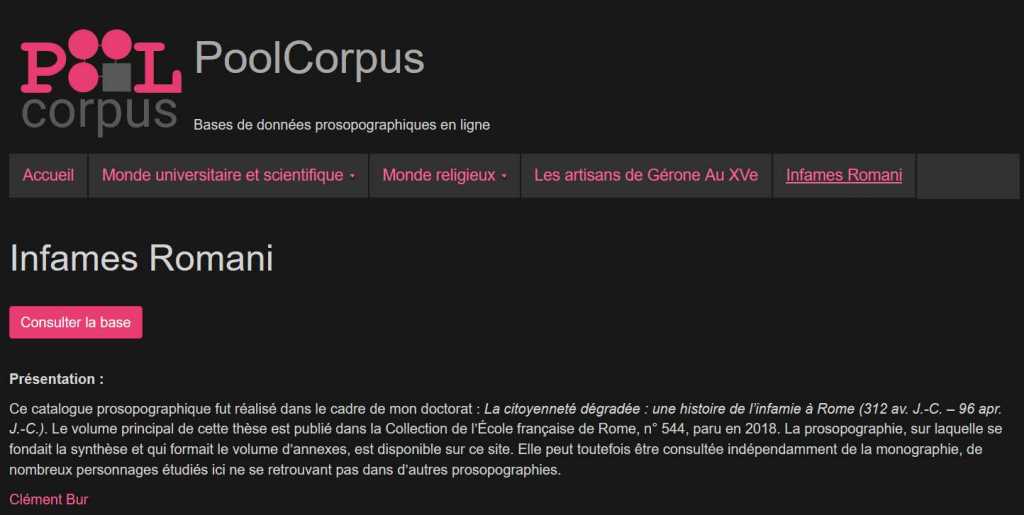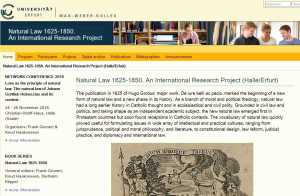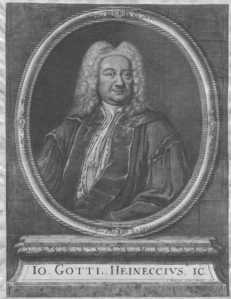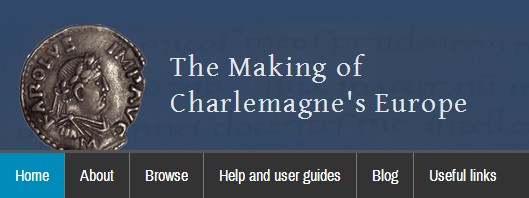
An aspect of the COVID-19 pandemic affecting scholarly research was and is restricted access to archives, libraries and museums. Online materials became even more important for both teachers and students than they did already before 2020. Classicists have embraced the possibilities of the internet and grasped also the use of digital humanities to widen and deepen their research, and to present the results in often interesting ways. At my blog and website I try to find and follow projects with a connection to legal history. While updating and reassessing the information about Roman law on my website I encountered at least three databases that I had missed earlier on or are simply still rather new. I certainly would like to make here some amends for the times Roman law came only seldom here into view. Apart from a presentation of the three databases I will also briefly mention some of the latest additions to my links list for Roman law. In this year’s Open Access Week it is good to know these resources can be accessed freely.
The Romans and infamy
The first database I would like to present is Infames Romani, the project of Clément Bur hosted at the PoolCorpus platform of the Institut National Universitaire Champollion (Albi-Rodez-Castres). It was a pleasant surprise to find this new element on a platform created for hosting biographical and prosopographical databases which until recently focused on students at French universities, mainly during the Early Modern period. Clément Bur wrote his PhD thesis La citoyenneté dégradée : une histoire de l’infamie à Rome (312 av. J.-C. – 96 apr. J.-C.) (Rome 2018), published by the École française de Rome. The database builds on his thesis concerning citizens whose behaviour or position in society led to marking them or simply made them infamous. People not just lost certain civic rights, they were outright degraded also by humiliating and infamous penalties.
The database with 210 cases distinguishes six penalties, everyone of them with subcategories, and a number of general cases. You can search by name, period, and the kind of penalty with additional subcategories. Bur limited his research to the late Roman Republic and the first century of the Roman empire. Entries contain the text or texts mentioning a person and references to scholarly literature. In this introduction to the database Bur explains concisely his scope and aim, and he gives his definition of persons affected by infamy. He indicates the main resources used for his corpus, and he mentions a few specific categories not included.

Among the databases Bur used one deserves some attention here. I wonder how I had not seen earlier on the database for Trials in the Late Roman Republic based on Michael Alexander’s Trials in the Roman Republic 149 BC to 50 BC (1990; 2nd ed., 2007) and extended by him, Tracy Deline and Federico Russo with the cooperation of others. The creation of this website started already in 2014, and because it is not a new database I will mention it only briefly here. The book has been converted both to HTML and XML. You can search the database with an XPath form or with Balbus. A second version of the database is currently work in progress. The TLRR database contains 391 cases, treated very summarily, and thus in this succinct form it has clearly to be consulted in tandem with Alexander’s monograph, available as a PDF at the TLRR website.
Roman bastards, a title with a twist

The team behind the Roman Bastards Database surely has a very sharp definition of Roman bastards, illegitimate children, but I hesitated to put this database here as the first item. Its title might easily be seen by the general public as a project for studying the most horrible Romans with the lowest characters and most brutal manners, the kind of persons figuring as the bad guys in movies with Roman history as its background or pretext. In their database Maria Nowak and Małgorzata Krawczyk of the Uniwersytet Warszawski bring together evidence on illegitimate offspring during the first three centuries of the Roman empire.
This database allows both searching and browsing, the last way not yet for legal sources alas, and you can use the analytical tools section for creating graphs of the occurrence of terms or their geographical distribution. The database contains currently 1828 items. Information about persons is divided over eight fields. Eight other fields contain information about the source for this person, with information about the exact text, the role of the person in the source, its date and provenance, links to online sources and references to scholarly literature. My first impression is that this database allows detailed searching for its subject, with as a bonus when needed links to external resources such as inscriptions and papyri. Some elements are not yet up and running, for example the list of abbreviations. The team scores points with clear user instructions.
A textual database for Justinian’s Digest
The third database in this post comes not as an online relational database, and not even as web pages using PHP or MySQL. For the Justinian Digest Marton Ribrary (University of Surrey, Guildford) has developed in 2020 a relational database which you can download and install yourself. The SQLite database has been written in Python and comes with sample queries. Ribrary developed this database in 2020 clearly to facilitate the integration of the Digest’s text – taken from the well-known Amanuensis app for Roman law – with some other resources, in particular the data created by Tony Honoré about Roman lawyers and their language.
Ribrary notes there are at least five other online versions of the Justinian Digest. He aims at a more structured presentation allowing more than just philological research, but also use as an artificial intelligence resource. In my view it is in the end helpful to be able to access and use texts in different formats. They allow for different approaches. Of course I added to my website the versions of the Digest in online libraries with Latin texts which did not yet figure on it. By mistake Ribrary suggests the Perseus Digital Library has a digital text of the Digesta. The Corpus Iuris Civilis is only part of its catalogue of texts.
A quick look at some recent additions
The typical thing to do with my web page for Roman law was first of all repairing broken links, a never ending task. During searches for correct URL’s I sometimes discover new projects well worth including, too, and this redeems my efforts. The section with the various original texts for Roman law needed a clearer layout. When necessary translations in print have been separated from digital versions.
This month I checked again the DigilibLT: Biblioteca digitali di testi latini tardoantichi created at the Università di Piemonte Orientale. Earlier on no legal texts from Late Antiquity were present at this portal, but in 2020 this has changed. The DigilibLT comes with an Italian and English interface. You can both read – and after registration download – several legal texts as PDF or TEI files. There is a PDF in English with an overview of the texts included and the editions used.
Among online journals for Roman Legal history The Journal of Juristic Papyrology deserved a place. It appears since 1946 and is available in open access. In the section with bibliographies I could add TOCS-IN: Tables of Contents of Journals of Interest to Classicists, hosted by the University of Toronto and the Université Catholique de Louvain, an online service with both an English and a French search interface. After adding the first two databases discussed here it was only logical to add the Prosopographia Imperii Romani of the Berlin-Brandenburgische Akademie der Wissenschaften, the database version of the biographical lexicon of people holding public offices in the Roman empire for the first three centuries of the Roman empire.
My web page ends with a number of online resources and portals helping you to find quickly texts, tools and other materials concerning classical Antiquity. I was much impressed by the commented list presented as Open access resources in 2020 and 2021 by the Institute of Classical Studies, School of Advanced Study, London. The section on law could be a bit more extensive, but for other subjects the choice of links offers a splendid fleet of resources now available in open access, for example for subjects such as epigraphy and papyrology. This list is a good reminder that only by looking wide and far, and sometimes quite close to your own town or country. other scholars and institutions make great efforts to help the scholarly community at large. Gaps and omissions can be filled when you look around carefully, but also by the help of kind people alerting others to things that might be of interest to them. I would like to hear, too, about such things! Hopefully this spirit of cooperation will remain a cherished and stable element, too, in the present world where individualism can steer you away from communicating with others.










